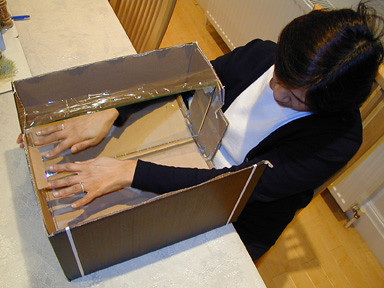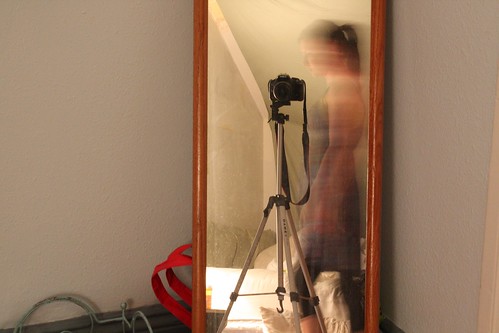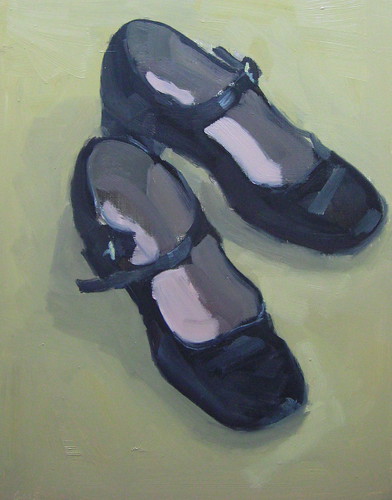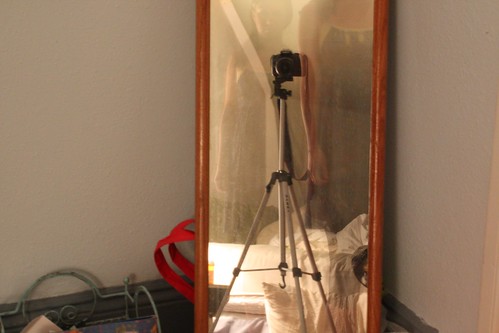(noon. – promoted by ek hornbeck)
Cross posted at DailyKos, ePluribus Media and Tikkun Daily.
Abstract: Current research in the cognitive sciences and neurology abounds in astounding theories on the locus of long-term memory; the ability of the brain to repurpose sections to recreate neural pathways totally destroyed by strokes, head injuries, or severe mental disabilities; and the intricate interplay of powerful emotions and complex neural coding in ‘reliving’ past traumas.
Drawing upon findings on the use of mirror boxes to threat phantom limb pain, on the role of our senses in unconsciously triggering highly emotive memories capable of transporting our consciousness beyond time/place constrictions, and the always miraculous studies of neurologist Oliver Sachs, herein is a different take on treatment for conditions such as chronic pain, strokes, and mental and affective disabilities.(Note: if possible, go to diary end to play music as you read)
 There is this one story in Oliver Sach’s Musicophilia: Tales of Music and the Brain which remains readily retrievable in my memory. A story so utterly mind-boggling, so counter-intuitive, so, as it were, against the grain, that it has hunkered down in my hippocampus, leaving an indelible imprint in the very cellular structure of my brain.
There is this one story in Oliver Sach’s Musicophilia: Tales of Music and the Brain which remains readily retrievable in my memory. A story so utterly mind-boggling, so counter-intuitive, so, as it were, against the grain, that it has hunkered down in my hippocampus, leaving an indelible imprint in the very cellular structure of my brain.
The Chapter “Pitch Imperfect: Cochlear Amusia” begins with a quote from Shakespeare’s Troilus & Cressida: “Untune that string/And hark, what discord follows!”
Here’s a paraphrase.
An aging renowned composer and conductor visits Sachs to discuss the ever-increasing difficulties in his music pursuant to his increasing hearing loss, accompanied by the loss of absolute pitch. Sachs, along with auditory specialists, concur that the problem is irreversible, due to the natural die off of some of the 4500-odd hair cells within the ear’s Organ of Corti. The musician learns to compensate, composing and directing in lower registers (even when these variations grow from 1/4 to over 1 full octave in discrepancies) and soon discovers he can make contextual ‘auditory’ corrections when working in full orchestra as opposed to with solo cellos, violas, or trombones. He begins to entertain the notion that his problem may be more in his brain. Some time goes by before Sachs receives a letter from the composer, informing him that he has regained his sense of absolute pitch, that once again he can accurately compose, hear and direct music. The change occurred after he received a commission which involved his total immersion in the composition of complex orchestral pieces. Sachs concludes that, despite the non-functionality of significant parts of the musician’s auditory processing facilities, becoming totally immersed in music for an extended time, reactivated his cellular musical memory, which resides inside the brain.
For some people, music can actually change the structure of the brain. Researchers have found that an area of the brain called the corpus callosum is enlarged in professional musicians.
Another part of the brain is enlarged in musicians with absolute pitch. A person with absolute pitch can identify or recreate a musical note without the help of a musical instrument.Link
Memory: Structure, Locus et al
“When from a long distant past nothing subsists, after the people are dead, the things are broken and scattered, taste and smell alone, more fragile but enduring, more unsubstantial, more persistent, more faithful, remain poised a long time, like souls, remembering, waiting, hoping, amid the ruins of all the rest; and bear unflinching, in the tiny and almost impalpable drop of their essence, the vast structure of recollection.” Marcel Proust, Swann’s Way
 I have been fascinated with memory since reading À la recherche du temps perdu, particularly that remarkable and famous scene in which our hero dips a petite madeleine into a spot of tea and experiences a flashback to an ecstatic moment in time: his childhood days in Combray on a morning when his Aunt Leonie offered him a taste of a madeleine she had dipped in her special brand of tea. The entire body of Proust’s multi-volume tome focuses (time and time again) on the role of sensory experiences in triggering involuntary memories.
I have been fascinated with memory since reading À la recherche du temps perdu, particularly that remarkable and famous scene in which our hero dips a petite madeleine into a spot of tea and experiences a flashback to an ecstatic moment in time: his childhood days in Combray on a morning when his Aunt Leonie offered him a taste of a madeleine she had dipped in her special brand of tea. The entire body of Proust’s multi-volume tome focuses (time and time again) on the role of sensory experiences in triggering involuntary memories.
Jonah Lehrer writes: “Neuroscience now knows that Proust was right…This is because smell and taste are the only senses that connect directly to the hippocampus, the center of the brain’s long-term memory…All our other senses (sight, touch, and hearing) are first processed by the thalamus, the source of language and the front door to consciousness. As a result, these senses are much less efficient at summoning up our past…Proust intuited this anatomy”. LINK
The author of Molecules of Emotion: Why You Feel the Way You Feel, Candace Pert, suggests that cellular memories, which actually are found in neuropeptides in tissues throughout the body, suggests a physiological connection between memories, body organs and the mind. “Memories are stored not only in the brain, but in a psychosomatic network extending into the body,” she writes.
It is these ‘physiological connections’ which play an active role in whether memories remain unconscious or raise to consciousness.
Similarly, University of Arizona scientists and co-authors of The Living Energy Universe, Gary Schwartz, PhD, and Linda Russek, PhD, hypothesize ‘the universal living memory” theory which states that “all systems stored energy dynamically . . . and this information continued as a living, evolving system after the physical structure had deconstructed.” (Interesting side note: Schwartz and Russek believe this may explain how the information and energy from the donor’s tissue can be present, consciously or unconsciously, in the recipient.)

The Journal of Neuroscience presents research suggesting that the amygdala and the neurotransmitter norepinephrine are pivotal in initially processing memory storage elsewhere in the brain. The amygdala, in regulating the intensity of the body’s emotional response to an event, not only determines how the event is initially experienced but also how it is stored in long term memory. The decoding involved in this process influences learning as well as memory.
Loop the Loop: The Hippocampus
First off, a review of the three different types of memory
1. Working. Short term, active, like RAM, holds only 4 to 9 items at at time. a temporary potentiation of neural connections that can become long-term memory through the process of rehearsal and meaningful association.
2. Declarative. Long term. hard drive. Facts figures, names. Experiences and memories. Like working memory neural connections can facilitate long-term memory through rehearsal and meaningful association. Locus: Hippocampus, entorhinal cortex, and perirhinal cortex, possibly stored in temporal cortex.
3. Procedural. Actions, habits, or skills learned by repetition.Stored by the cerebellum and the striatum Link
And then there is emotional memory, which is associated with strong emotions and can involve both procedural and declarative memory. These memories are not readily accessible but are instrumental in effecting powerful unconscious reaction and follow a physiological pathway of complex connections between the amygdala and the prefrontal cortex.
Now, here’s some heady stuff about the hippocampus, so take what you want and leave the rest: (emphasis is mine)
The time-limited role of the hippocampus for explicit memory storage has been referred to as systems consolidation where learning-related changes occur first in the hippocampus followed by the gradual development of a more distributed memory trace in the neocortex. Recent experiments are beginning to show that learning induces plasticity-related molecular changes in the neocortex as well as in the hippocampus and with a similar time course. Present memory consolidation theories do not account for these findings.
In this report, we present a theory (the C theory) that incorporates these new findings, provides an explanation for the length of time for hippocampal dependency, and that can account for the apparent longer consolidation periods in species with larger brains. This theory proposes that a process of cellular consolidation occurs in the hippocampus and in areas of the neocortex during and shortly after learning resulting in long-term memory storage in both areas. For a limited time, the hippocampus is necessary for memory retrieval, a process involving the coordinated reactivation of these areas. This reactivation is later mediated by longer extrahippocampal connectivity between areas. The delay in hippocampal-independent memory retrieval is the time it takes for gene products in these longer extrahippocampal projections to be transported from the soma to tagged synapses by slow axonal transport. This cellular transport event defines the period of hippocampal dependency and, thus, the duration of memory consolidation. The theoretical description for memory consolidation presented in this review provides alternative explanations for several experimental observations and presents a unification of the concepts of systems and cellular memory consolidation. Link
The Itch and The “Best Guess’ Theory
Atul Gawande’s article The Itch in a June 2008 issue of The New Yorker details the story of a woman, “M”, who after an attack of shingles, is obsessed with an itch on her right scalp. After consulting with internists and innumerable tests and treatments, she is diagnosed with a form of OCD, tricho-tillomania, which exhibits with a patient’s overwhelming urge to pull out their hair.
One morning, after she was awakened by her bedside alarm, she sat up and, she recalled, “this fluid came down my face, this greenish liquid.” She pressed a square of gauze to her head and went to see her doctor again. M. showed the doctor the fluid on the dressing. The doctor looked closely at the wound. She shined a light on it and in M.’s eyes. Then she walked out of the room and called an ambulance. Only in the Emergency Department at Massachusetts General Hospital, after the doctors started swarming, and one told her she needed surgery now, did M. learn what had happened. She had scratched through her skull during the night-and all the way into her brain.
According to the article ‘itch’ cannot be separated from the desire to scratch. “The itch-scratch reflex activates higher levels of your brain than the spinal-cord-level reflex that makes you pull your hand away from a flame. Brain scans also show that scratching diminishes activity in brain areas associated with unpleasant sensations.”
A neurologist, who visited “M”in this hospital prior to her institutionalization, tested the skin near her wound and determined it did not register temperature, touch or pinpricks. She injected local anesthetic and the itching stopped almost immediately, but it returned when the anesthetic wore off. A test on the itchy patch of skin revealed that ninety-six per cent of the nerve fibres were gone. So why was the itch so intense? The doctor concluded that either “M’s” remaining nerve fibers were constantly active because they lacked other nerve fibers surrounding them to emit competing symbols OR that the itch represented a syndrome run amok and running on a perpetual loop of its own.
The neurologist believed “M” had a brain problem and not a nerve problem, but “M”, desperate for relief, allowed neurosurgeons to cut the main sensory nerve emanating towards the front of her scalp above her right eye. When she awoke from the procedure, a large swatch of her forehead was numb: No itching. But in a matter of weeks the itch returned and spread to an even larger area. “M”, forced to wear a foam football helmet with her wrists bound at night to her bedrails, was eventually institutionalized for two years: She was considered a threat to herself.
The prominent British neuropsychologist, Richard Gregory, suggests visual perception accounts for more than 90% of memory, with less than 10% involving sensory nerve systems.
“The account of perception that’s starting to emerge is what we might call the “brain’s best guess” theory of perception: perception is the brain’s best guess about what is happening in the outside world. The mind integrates scattered, weak, rudimentary signals from a variety of sensory channels, information from past experiences, and hard-wired processes, and produces a sensory experience full of brain-provided color, sound, texture, and meaning.”
“The Itch” determines the problem is brain based and that patients with nerve problems, diseases, or injuries might actually be suffering from ‘sensor syndromes.’
The Marco Polo of Neuroscience
The physician who initiated work with mirror boxes,V.S. Ramachandran, known as “the Marco Polo of Neuroscience” is Director of the Center for Brain and Cognition and Professor with the Psychology Department and Neurosciences Program at the University of California, San Diego, and Adjunct Professor of Biology at the Salk Institute. (View his page on Illusions). Ramachandran refers to his work as ‘mirror visual feedback.” He spoke at the 2007 TED conference Talks VS Ramachandran on your mind.
 Mirror box therapy is currently being successful in rehabilitating complex regional pain syndrome in both upper or lower limbs.
Mirror box therapy is currently being successful in rehabilitating complex regional pain syndrome in both upper or lower limbs.
Gawanda visits with “M” towards the end of his article and then discusses her case with Ramachandran who suggested that perhaps mirror therapy would work for her. Another person, perhaps, could scratch the left side of her head and trigger a sense of dissonance in her brain which might reset her sensory perceptions.
While drug treatment can allow patients to ignore sensors, mirror treatment deals with the problem directly by targeting the sensor system. The key is to manipulate a sensor which is misfiring, either under the assumption that something is wrong with oneself or with the external world and then sent it “an alternate set of signals that calm it down. The new signals may even reset the sensor.”
Interestingly enough, this explains why the suggestion to ‘work through the pain.’ is effective. Sometimes, even after the tissue pain is gone, the pain sensors continue to ignite. Working through the pain provides the brain with a “contradictory feedback-a signal that ordinary activity does not, in fact, cause physical harm. And so the sensor resets.”
In a May 27 posting in The Last Psychiatrist Ramachandran’s Mirror, the author discusses a patient he had been treating for MDD using Effexor and Restoril. Although the patient also had an above the elbow amputation and suffered often from phantom limb pain, and although he was well aware of the success of Ramachandran’s mirror therapies, he didn’t consider using the treatment for three years! Here is a recount of what occurred when it finally clicked that he could work ‘outside the box’:
I was a little nervous, I don’t mind telling you this up front.
I set up the mirror just as Ramachandran had described. At first she didn’t really get it, she wiggled her fingers, and nothing was happening.
“What I want you to do,” I ad libbed, “is look in the mirror, and imagine that your left hand is doing the exact same thing as your right, simultaneously.” I showed her by opening and closing my fists. “In other words, open and close both of your fists.”
I barely finished my sentence when her eyes popped wide. “Oh my God. Oh my God.”
My eyes popped open, too– it actually worked!
We did that for a minute, and I asked her to then play a scale on an imaginary piano, 1-2-3-4-5-4-3-2-1, with “both hands.”
She started crying. This isn’t an exaggeration. “I can’t believe this. I can actually feel my hand…”
This, I thought with immense pride, is awesome.
Without ducking responsibility, what’s wrong with medicine today is that it is predicated on providing treatment, not on reducing suffering. Not on solving problems.
Doctors, he laments, treat results.
Think about how much controversy there is over using medications that are already approved off label for something else. Where, then, is the cognitive strength to do something that isn’t even considered a treatment?
Most residents fantasize about doing something like the mirror on a patient, partly because it sounds cool, but unfortunately really because it puts them on an equal footing with their supervisors. They’ll never know as much about Treatment Guidelines For Bipolar XVI as their supervisors, but they can know more about this. This is how they can distinguish themselves.
Once they grow to the point where they are knowledgeable about the Guidelines, then there’s no reason to use mirrors.
The Guru of Neuroplasticity
It was back in the 1960’s that neuroscientist Paul Bach-y-Rita initiated the idea that the brain could utilize one sense to compensate for another. This theory of neuroplasticity was in direct opposition to prevailing theories which worked from the premise that sensory processes where unalterably hardwired.
In his recent book The Brain that Changes Itself Norman Doidge recounts the story of Bach-y-Rita’s father, Pedro, and his recovery from a stroke.
“His brother George, a medical student at the time, helped their father relearn to walk, teaching him first to crawl. Pedro went on to regain his speech and learned to write again on a typewriter. He even resumed his job as a professor, and remarried, worked, traveled and hiked until he had a heart attack and died while climbing in the mountains of Colombia.
“Bach-y-Rita recalled his father’s autopsy. Upon seeing layers of his father’s brain, he felt “revulsion” but then an epiphany: “[W]hat the slides showed was that my father had had a huge lesion from his stroke and that it had never healed, even though he recovered all those functions. .. I knew that meant that somehow his brain had totally reorganised itself with the work he did with George.” Link
Bach-y-Rita’s believes that the sensory-loaded, two-dimensional sheets, which form our touch receptors and the skin, are ‘data ports,’ capable of creating a picture, thereby substituting for a retina.
The brain decodes these skin sensations and, in turn, reconverts them into pictures. Therefore, the brain is learning or adapting, which signifies its plasticity: It is capable of reorganizing its own sensory perceptual system. Link
Music, Mirrors & the Illusory Self
Imagine if we could use mirrors to re-ignite memories of ourselves at a previous time, before a particular health problem damaged our bodies, our psyches, our self concept. What if what is actually involved in our perceptions of ourselves is what scientists are currently referring to as the “best case scenario.”
So my experiment involves a treatment which will manipulate my perception of myself. I’ll need a mirror in which my entire body is visible, and a wide array of sensory triggers which (much like Proust’s madeleine) will transport me back to a time in my life when I was happy, a time before or a time in-between episodes of Major Depressive Disorder (MDD).
So here is my proposed experiment. Let’s walk in.

Stepping into an illusory self. Photo by Lizzy Phelan. 2009.
I immerse myself in sensations reminiscent of pre-onset or inter-episodic periods of time when I was free from the symptoms of MDD. To conduct this experiment, I need a full length mirror(s) in which my entire body is visible, possibly a camera with an extremely wide shutter, on extremely slow speed so as to catch a phantom sense of motion. A stable tripod. A collection of sensory triggers sufficient to create a totally immersed experience. A commitment to repetition of the experiment over an extended period of time. A strong desire to ‘work through the pain.’
My Sensory Triggers
Music: Rachminoff Piano CONCERTO #2 in C Minor

Clothing: Little girls’ black patent leather shoes

Book:Angel on Skiis

Taste: Black and White cookies from The Brownie Bakery in Farmingdale, NY

Scent: autumn leaves burning curbside at dusk in New York
I position the mirror so that I have a full body view of my self in two dimensions, one of which is closer up, the other further back, significantly less visible, illusory … a phantom self.
Next, I surround myself with my sensory triggers, the patent leather shoes, some autumn leaves burning in a large urn, a copy of Angel on Skiis, a video of me ice-skating in the Farmingdale sandpit screening behind me, visible in the mirror.
Then, I turn on the music and step in.

Photo by Lizzy Phelan. 2009
Rachmaninoff: Piano CONCERTO #2 in C Minor.


7 comments
Skip to comment form
it’s a good place for it – this work of yours takes some time to process!
So true, our “health” system just tries to numb negative sensations, rather than help us get back (or for the first time) to the point where we felt whole, or better, anyway! If I didn’t use music as therapy, I’d be utterly incapacitated by now (silent strokes, broken bones, arthritis, blues). And samE (natural enzymes, not for bipolars, ok?). And a Japanese blend of epson salts. And novels to rekindle the imagination. And my dogs and the ocean and natural trails. And always, always, loving friends to care about and to show they also care.